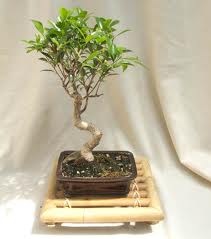 Bonsai is the art of creating miniature potted trees. The term is also applied to other forms of small-scale gardening, such as miniature penjing landscapes. Bonsai is considered an art because it requires more than chopping off a few limbs and a pretty pot to create a true masterpiece. Bonsai takes time to train and even longer before it can be considered "finished." Not all trees are bonsai quality, so knowing what to search for will eliminate a few beginner mistakes.
Bonsai is the art of creating miniature potted trees. The term is also applied to other forms of small-scale gardening, such as miniature penjing landscapes. Bonsai is considered an art because it requires more than chopping off a few limbs and a pretty pot to create a true masterpiece. Bonsai takes time to train and even longer before it can be considered "finished." Not all trees are bonsai quality, so knowing what to search for will eliminate a few beginner mistakes.
Serissa
Serissa is popular as a bonsai. This perennial shrub has tiny leaves that can be less than half an inch long. When in bloom, serissa is covered in single or double star-shaped blossoms that are colored from white to pink. It prefers well-drained soil with plenty of moisture.
Blue Juniper
Blue juniper is an evergreen tree with a blue cast to its needles. Its compact size and small needles make it an excellent choice for bonsai culture. This juniper does best in well-drained soil with monthly feedings of a 20-20-20 fertilizer. The soil should never remain wet, and it should be allowed to dry out slightly between watering. Blue junipers like full sun and daily water misting.
Lantana
Lantana is a fast-growing blooming shrub of the family Verbenaceae. In cold climates it grows as an annual, so lantana bonsai should be overwintered indoors or in a greenhouse. Allow the soil to dry out slightly between watering, and feed it every two to three weeks during the growing season with a balanced bloom bonsai fertilizer. Due to its fast growth, lantana requires regular pruning of extra limbs, or it will look bad.
Azalea
Grown for the masses of brightly colored blooms the plants produce, azaleas are popular as bonsai. Provide well-drained acidic soil with plenty of slow-release fertilizer geared toward blooming plants. During the active growth season, azaleas are heavy feeders. They like partial shade and plenty of water.

Deprecated: strpos(): Passing null to parameter #1 ($haystack) of type string is deprecated in /home/agriviek8Qv/agriviet.net/public_html/wp-includes/comment-template.php on line 2522